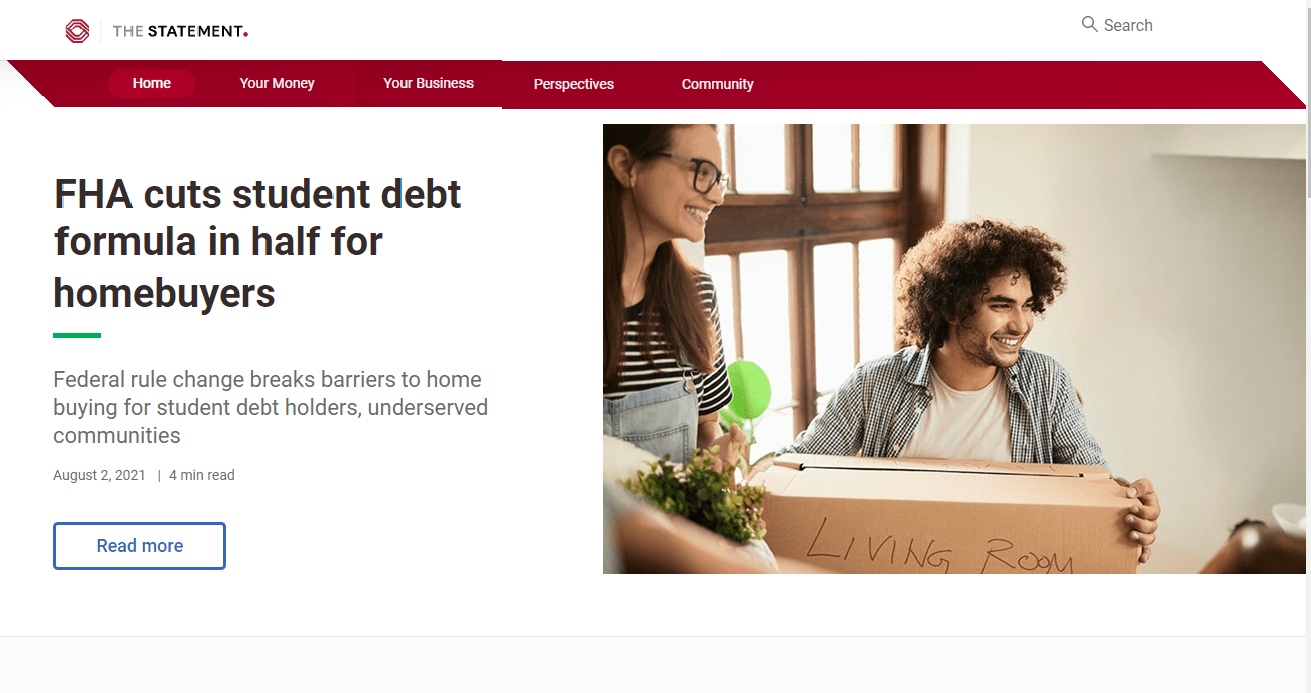For BOK Financial, words matter as much as the numbers
A look inside why and how the bank launched a brand journalism site during the pandemic—and the coverage it’s attracted from the press.

Remember March’s GameStop investing frenzy? If you aren’t a financial expert, you were probably trying to find out how a group of people on Reddit could drive up the video game retailer’s stock by 1,500%.
Among the myriad stories, some of the most clearly written were found in The Statement, a “brand journalism” site published by BOK Financial.
“Those stories did really well,” says Sue Hermann, the financial company’s director of corporate communications and content. “Our investment management team was super responsive and willing to chat with us right away and explain the situation to us. It’s an example of a successful brand journalism approach. We were able to own that content.”
Brand journalism is different from content marketing, because it’s not marketing—It’s journalism. “Brandjo” as proponents often call it, requires communications professionals to think like publishers, editors, journalists, and web designers—a team coming together to tell fact-based news and feature stories with multiple sources. Yes, the stories are in the brand’s interests. But after that, you let the people and the facts tell the truth.
[FREE GUIDE: Brand Journalism on the inside]
Content in the time of COVID-19
Hermann and Megan Ryan, the bank’s senior strategic content manager, officially launched The Statement in March with a bespoke website design, logo and editorial team. But they began publishing feature stories about personal and business finance topics a year earlier, as COVID-19 was changing life as we know it.
Back then, their vision for The Statement was just that: they hadn’t even named the publication yet. With people clamoring for information on topics such as stimulus checks, Ryan rose to the challenge, writing stories and posting them on the website’s Insights section.
“We wanted to put out content to help people,” Ryan says. “There was such a demand for client- and public-facing content that we decided to get started publishing right away and it ended up being a full year before the brandjo site was up and functioning. We published on an unlinked page—not the best process in the world but it’s what we needed to do.”
Since then, Hermann and Ryan have created a 10-person editorial team consisting of full-time employees and freelance writers. They hold weekly pitch meetings to identify story ideas—from mortgage rates to wealth management strategies – and use Trello to manage each assignment. They’ve published nearly 200 stories since March 2020, sometimes as many as eight a week. And they do this while managing every other aspect of communications: media relations, employee engagement, investor relations.
“It helps to have a Megan Ryan,” Hermann says. “She is fantastic at thinking through process. Discipline is key to publishing quickly.”
Bankers as sources
Telling stories also requires support from the bank’s leadership and relationship managers, who are now finding themselves in another role: sources.
“We thought there would be a heavier need to sell this idea inside the bank,” Hermann says. “But once people started to see the stories, they got behind it. There is a huge demand, internally and externally, for the opposite of sales—for information that focuses on the needs of the user, and is not necessarily completely driven by the bank’s needs.”
To be sure, asking bankers to become sources did require some education.
“It was a big shift, a totally new concept,” Ryan says, “But the fact that we’re able to put things out as quickly as we are, from a broader economic perspective, helps to build the reputation of the company, and that helps our team members develop relationships with people in their networks.”
Google approves, and other brandjo lessons
The regular cadence of stories is having a positive effect on search engine optimization. When people search for BOK Financial, The Statement’s stories rank at the top appear.
“Google really likes The Statement, and the fact that we have fresh content that’s original,” Ryan says. “This is much more frequently updated than anything else on our website.”
Amidst the SEO boost, the team is also deploying a strategy to increase social engagement, especially on LinkedIn. At the same time, some of the content is generating media coverage in other outlets; the GameStop stories led to articles in Digital Journal and Authority Magazine on Medium.
Meanwhile, another fact is revealing itself time and time again.
While businesspeople will likely always need PowerPoint, or something like it, to advise a client or sell a product, nothing connects people like stories do.
“The power of storytelling has been proven since the early days of man,” Hermann says. “We are preprogrammed to remember and share stories, and this aligns directly with that.”
Ryan says it’s easier to relate to people when you read a story about them. “It’s better than bullets and statistics alone,” she says. “People are looking for explanations, for an understanding. And I think that’s what brand journalism is good at doing. Instead of a wash of information, it has a hook to create a connection. Which we’re all looking for.”
BOK Financial is a client of Chicago-based Ragan Consulting Group. RCG specializes in corporate communications training, consulting and strategic counsel. Schedule a call with Kristin Hart to learn how we can help you improve your storytelling and media strategy. Follow RCG on LinkedIn here.






